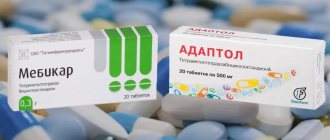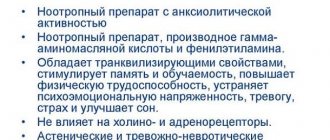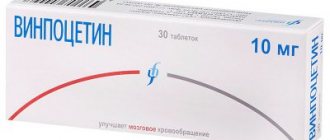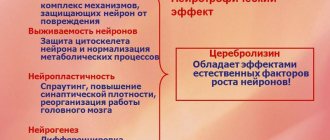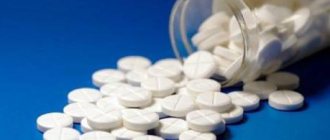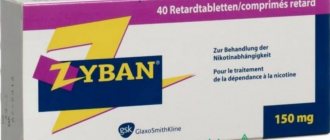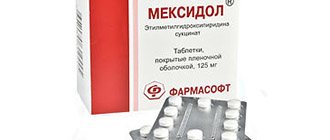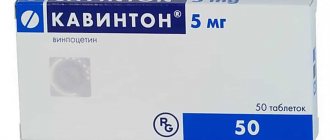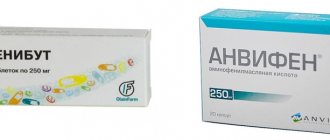Nosological classification (ICD-10)
- F06.6 Organic emotionally labile [asthenic] disorder
- F10.3 Withdrawal state
- F41.9 Anxiety disorder, unspecified
- F48.9 Neurotic disorder, unspecified
- F95.9 Tics, unspecified
- F98.0 Enuresis of inorganic nature
- F98.5 Stuttering [stammering]
- G47 Sleep disorders
- H81.0 Meniere's disease
- H81.4 Dizziness of central origin
- H81.9 Vestibular function disorder, unspecified
- T75.3 Motion sickness
Indications for use of Anvifen
A nootropic is prescribed for the following disorders and pathologies:
- asthenia;
- anxiety and neurotic conditions;
- stuttering, tic, enuresis in a child;
- sleep problems;
- Meniere's disease;
- dizziness, which is associated with dysfunction of the vestibular analyzer;
- motion sickness due to seasickness during travel.
Attention! The drug is not recommended to be taken during pregnancy or breastfeeding. It is prescribed with caution to patients with erosive and ulcerative formations in the gastrointestinal tract, as well as with liver failure.
Compound
| Capsules | 1 caps. |
| active substance: | |
| aminophenylbutyric acid hydrochloride | 25 mg |
| 50 mg | |
| 125 mg | |
| 250 mg | |
| excipients: hyprolose - 1.3/1.3/1.7/2 mg; colloidal silicon dioxide - 3.2/3.2/4/8 mg; lactose - 109.1/84.1/42.5/86.5 mg; magnesium stearate - 1.4/1.4/1.8/3.5 mg | |
| hard gelatin capsule: for a dosage of 25 mg - water, gelatin, titanium dioxide (E171); for a dosage of 50 mg - water, gelatin, azorubine dye (E122), brilliant blue dye (E133), quinoline yellow dye (E104), titanium dioxide (E171); for a dosage of 125 mg - water, gelatin, azorubine dye (E122), brilliant blue dye (E133), titanium dioxide (E171); for a dosage of 250 mg - water, gelatin, azorubine dye (E122), brilliant blue dye (E133), titanium dioxide (E171) |
Analogs
Let's look at medications that are analogs and substitutes for Anvifen.
Preparations containing aminophenylbutyric acid as the main active ingredient are considered analogues and synonyms of Anvifen. And products with a different composition but a similar effect are substitutes.
In pharmacies, drugs are sold according to a doctor's prescription. Due to the fact that aminophenylbutyric acid relates not only to medicines, but also to sports nutrition, Anvifen and its analogues can be purchased on specialized websites without prescriptions.
Complete analogues of Anvifen in substance include Phenibut and Noofen.
Phenibut
Like Anvifen, it is a medicine that has nootropic and anti-anxiety effects:
- improves the activity of brain functions;
- normalizes microcirculation and blood flow processes;
- helps cope with anxiety and agitation, depression, phobias;
- does not cause sedation.
Phenibut is prescribed for the same diagnoses as Anvifen. The main active ingredient is also aminophenylbutyric acid. At the same time, the composition of the auxiliary components is slightly different.
It differs in the form of release - it is available in capsules, tablets, and powders. The dosage is most often standard – 250 mg. Produced not only by Russian manufacturers, but also by foreign ones. Products produced in Latvia and the USA with higher quality raw materials and manufacturing processes. According to reviews, it has a more irritating effect on the gastric mucosa.
Noofen
Synonymous with Anvifen, produced in Latvia. Medicines from foreign manufacturers are better in quality and more expensive in price. The active ingredient is the same - aminobutyric acid hydrochloride, the auxiliary components are the same.
Noofen is prescribed in the same cases as Anvifen. Available in capsules with a dosage of 250 mg. A prescription is required when purchased from pharmacies.
Nootropil
A nootropic used to treat memory disorders, disorders of the brain, improve cognitive functions, increase concentration, attention, and learning ability. Similar in action, but does not have an anti-anxiety effect. The active ingredient is different - piracetam.
It has a larger list of contraindications, such as individual intolerance, stroke, Huntington's chorea, renal failure. The list of side effects of Nootropil is quite wide:
- nausea;
- vomit;
- diarrhea;
- weight gain;
- various manifestations of allergies;
- disorders of the blood and lymphatic system;
- excitation;
- anxiety;
- depression;
- hallucinations;
- confusion and others.
Fenotropil
An analogue that simultaneously has nootropic, anticonvulsant, neuromodulatory, and antiasthenic effects. Improves memory, attention, concentration, regulates the processes of activation and inhibition of the central nervous system, improves blood circulation, and improves mood.
It has a small list of side effects: insomnia, agitation, increased blood pressure, a feeling of increased warmth of the skin. The list of contraindications, compared to Anvifen, is higher. Do not take after 15:00. Similar in effect on the body, but with a different composition. The active substance is the same name, phenotropil. Available in the form of tablets of 50 and 100 mg.
Atarax
Similar in action. It is a tranquilizer and is prescribed for neurotic disorders, irritability, and anxiety. It has a depressing effect on the activity of certain areas of the central nervous system. The active ingredient is hydroxyzine hydrochloride.
The analogue has many side effects, such as decreased blood pressure, nausea, anaphylactic shock, increased fatigue, stool disturbances, dry mouth, impaired accommodation, low-grade fever, hallucinations, spatial disorientation, and drowsiness are possible.
Description of the dosage form
Capsules, 25 mg: hard gelatin, size No. 3, white.
Capsules, 50 mg: hard gelatin, size No. 3, white body, blue cap.
Capsules, 125 mg: hard gelatin, size No. 2, white body, blue cap.
Capsules, 250 mg: hard gelatin, size No. 0, white body, dark blue cap.
Capsule contents: a mixture of powder and/or granules of white or white with a yellowish tint.
Anvifen or Afobazol – which is better?
Manufacturer: Pharmstandard+, Russia
Release form: tablets
Active ingredient: fabomotizol
Afobazole is an over-the-counter analogue of Anvifen, which is prescribed to patients over 18 years of age. The drug restores and protects nerve cells, helps reduce or eliminate feelings of anxiety, irritability, tension, tearfulness, and restlessness. Helps to relax, cope with insomnia, depression, and somatic manifestations of anxiety. The drug is indicated for patients with asthenia.
The effectiveness of therapy is noticeable on the 5th–7th day of use, and the maximum result appears after a month’s course and lasts for 7–14 days. Does not provoke drowsiness or weakness.
Pharmacodynamics
A nootropic agent that facilitates GABA-mediated transmission of nerve impulses to the central nervous system (direct effect on GABAergic receptors). The tranquilizing effect is combined with an activating effect. It also has antiplatelet, antioxidant and some anticonvulsant effects.
Improves the functional state of the brain by normalizing its metabolism and influencing cerebral blood flow (increases volumetric and linear velocity, reduces vascular resistance, improves microcirculation, and has an antiplatelet effect). Extends the latent period and shortens the duration and severity of nystagmus.
Does not affect cholinergic and adrenergic receptors. Reduces vasovegetative symptoms (including headache, feeling of heaviness in the head, sleep disturbance, irritability, emotional lability). When taken as a course, it increases physical and mental performance (attention, memory, speed and accuracy of sensory-motor reactions).
Reduces manifestations of asthenia (improves well-being, increases interest and initiative - motivation for activity) without sedation or agitation.
Helps reduce feelings of anxiety, tension and restlessness, and normalizes sleep.
In elderly people, it does not cause depression of the central nervous system; the muscle-relaxing aftereffect is most often absent.
Anvifen or Adaptol – which is better?
Manufacturer: OLAINPHARM, Latvia
Release form: tablets
Active ingredient: mebicar
Adaptol is a prescription foreign analogue of Anvifen, which is prescribed to adults and children over 10 years of age. Refers to tranquilizers. Reduces anxiety, restlessness, fear, tension, irritability. Has a nootropic effect.
Does not have a negative effect on mental and physical activity. Does not have a hypnotic effect. Improves cognitive functions. Prescribed for the following pathologies:
- neuroses;
- cardialgia;
- nicotine withdrawal.
Pharmacokinetics
Absorption is high, penetrates well into all tissues of the body and through the BBB (about 0.1% of the administered dose of the drug penetrates into brain tissue, and in young and elderly people to a much greater extent). Evenly distributed in the liver and kidneys. Metabolized in the liver - 80–95%, metabolites are pharmacologically inactive. Does not accumulate. After 3 hours, it begins to be excreted by the kidneys, while the concentration in the brain tissue does not decrease and is detected for another 6 hours. About 5% is excreted by the kidneys unchanged, partially with bile.
Anvifen or Pantogam – which is better?
Manufacturer: PIK-PHARMA, Russia
Release form: tablets, capsules, syrup
Active ingredient: hopantenic acid
Pantogam is a prescription analogue of Anvifen. It is a nootropic drug that improves brain performance. Has a positive effect on mental activity and memory. Increases the brain's resistance to oxygen starvation and improves blood flow in this area. Slightly increases performance. The analogue also helps to cope with alcohol intoxication.
It has a significant list of indications, including epilepsy, neurogenic urination disorders, encephalopathy, and cerebral palsy. Prescribed for adults and children from three years of age.
Directions for use and doses
Orally, after meals, in 2-3 week courses.
Adults and children over 14 years of age - 250-500 mg 3 times a day (maximum daily dose - 2500 mg). Children 3–8 years old - 50–100 mg 3 times a day; 8 - 14 years - 250 mg 3 times a day.
The single maximum dose for adults and children over 14 years of age is 750 mg, for persons over 60 years of age - 500 mg, for children under 8 years of age - 150 mg, from 8 to 14 years of age - 250 mg.
Alcohol withdrawal syndrome: 250–500 mg 3 times a day and 750 mg at night, with a gradual reduction in the daily dose to the usual for adults.
Treatment of dizziness with dysfunction of the vestibular apparatus and Meniere's disease: 250 mg 3 times a day for 14 days.
Prevention of motion sickness: 250–500 mg once, 1 hour before the expected start of motion sickness or when the first symptoms of seasickness appear.
The anti-motion sickness effect of Anvifen® increases with increasing dose of the drug. When severe manifestations of seasickness occur (vomiting, etc.), the use of Anvifen® is ineffective even in doses of 750–1000 mg.
Price of Anvifen and its analogues
Anvifen - capsules for oral administration, which may contain 50 or 250 mg of the active component aminophenylbutyric acid per 1 piece. In the first case, the cost of the drug is approximately 234 rubles for 20 capsules. In the second - approximately 379 rubles for the same number of pieces.
Prices for the main Anvifen substitutes can be seen in the table.
| № | Drug name | Release form | Quantity pcs/1 package | Dose DC/pcs. (mg) | Price (rubles) | Pharmacy name |
| 1. | Phenibut | Pills | 10 | 250 | 58 | NeoPharmacy |
| 2. | Noofen | Capsules | 20 | 250 | 948 | E Pharmacy |
| 3. | Noobut | Pills | 20 | 250 | 550 | LanaFarm |
| 4. | Bifren | Capsules | 10 | 250 | 272 | ZdravCity |
| 5. | Nozepam | Pills | 50 | 10 | 85 | Apteka.ru |
| 6. | Alprazolam | Pills | 50 | 1 | 850 | Wer.ru |
| 7. | Fenzitate | Pills | 50 | 1 | 75 | LanaFarm |
| 8. | Glycine | Pills | 50 | 100 | 41 | E Pharmacy |
| 9. | Tenoten | Pills | 40 | 0.003 g | 235 | ZdravCity |
The table shows only approximate prices for the medications listed in it. The exact cost of a specific generic Anvifen can only be found out from a pharmacist or pharmacist.
[compare name=`Phenibut|Noofen|Noobut|Bifren|Nozepam|Alprazolam|Fenzitate|Glycine|Tenoten`]
See also:
TOP 7 analogues of Picamilon - Russian and foreign substitutes for the drug
Answers on questions
Is Anvifen an antidepressant or not?
The drug is a nootropic that also helps cope with depression.
Is Anvifen compatible with alcohol or not?
No. This medicine should not be combined with alcoholic drinks, even those with a low alcohol content.
Is Anvifen available with a prescription or not?
The medication is a prescription, so you must first consult with a specialist.
Anvifen or Picamilon - which is better?
Manufacturer: Pharmstandard+, Russia
Release form: injection solution, tablets
Active ingredient: picamilon
Picamilon is an analogue cheaper than Anvifen, which is available from pharmacies with a prescription. This is a nootropic that has a vasodilating effect on the blood vessels of the brain, and also normalizes metabolism in this area. It has tranquilizing, psychostimulating, antiplatelet, antioxidant properties.
Increases mental and physical performance, eliminates cephalalgia, improves memory, helps cope with insomnia, anxiety, tension, and fear. It has a positive effect on the condition of patients with motor and speech disorders.
It is also prescribed in complex therapy for pathologies of the retina and optic nerve, and is used in urology.
Non-addictive medications
The free sale of pregabalin and its substitutes in pharmacies is prohibited. But over-the-counter sales are allowed. These include medications, the composition of which is fundamentally different, but the effect is the same.
For fibromyalgia, the following are used as analgesics:
- nimesulide;
- diclofenac;
- ketoprofen.
These pregabalin substitutes inhibit the enzyme cyclooxygenase, which is responsible for the production of prostaglandins, bradykinins and leukotrienes. These are biologically active compounds on which the severity of pain in various pathologies in general and fibromyalgia in particular depends. The described remedies are not ideal - for example, they can cause individual intolerance. But they are valuable because they are not capable of provoking drug addiction.
Popular analogues include gabapentin, finlepsin and carbamazepine. Gabapentin is prescribed for relief of:
- epileptic seizures;
- neuropathic pain;
- postherpetic and alcoholic neuralgia.
Finlepsin and carbamazepine act as agents:
- antiepileptics;
- painkillers;
- normothymic (mood stabilizing);
- antimanic;
- antidiuretic.
Thanks to finlepsin and carbamazepine, the amount of chemicals in the body that lead to excitation and overexcitation of nerve structures is reduced. They do not cause drug addiction, but have other side effects. That is why they should only be prescribed by the attending physician - he knows the physiological characteristics of his patient well.
Anticonvulsant substitutes include Depakine Chrono. It acts like:
- muscle relaxant (relaxes muscles);
- sedative (calming).
Depakine Chrono does not cause mental and physical addiction, like pregabalin - its replacement is justified. It is used in the treatment of epileptic seizures - generalized (the so-called convulsive motor activity that extends to all muscle groups) and partial (those in which there is no impairment of consciousness). It is also effective in treating Lennox-Gastaut syndrome, a severe encephalopathy (brain damage) that first appears in childhood.
Anvifen or Mexidol - which is better?
Manufacturer: VECTORFAM, Russia
Release form: tablets, injection solution
Active ingredient: ethylmethylhydroxypyridine succinate
Mexidol is a domestic analogue that is an antioxidant drug. It has antihypoxic, stress-protective, nootropic, anticonvulsant and anxiolytic effects. Improves metabolism and blood supply to the brain. It has hypolipidemic properties, reduces the total cholesterol content in the blood.
Analogues of Anvifen are nootropics and tranquilizers that are prescribed to patients for various pathologies accompanied by impaired performance, cerebral blood flow, as well as anxiety, fear, and irritability. They have differences, including price, composition and pharmacology. A mandatory consultation with a specialist is required in advance.
Characteristics of the drug
It is used in the treatment of neurological pathologies such as:
- diabetic neuropathy - damage to peripheral nerves due to diabetes mellitus;
- postherpetic neuropathy is a similar disorder that occurs after suffering from herpes;
- epilepsy - seizures;
- neuropathic pain - those that arise due to overexcitation of nerve cells;
- fibromyalgia - musculoskeletal pain;
- generalized anxiety disorder is a condition characterized by restlessness, worry, and panic.
Addicts use higher doses of this medication to induce a feeling of euphoria. Quite quickly it leads to disorders of various organs. In addition, literally after one or two doses, dependence on pregabalin is formed - replacement with analogues is extremely important because of this.
Of the psycho-emotional disturbances that can be provoked by this drug, the most common are irritability, depression, and hallucinations. The most common neurological disorders are insomnia, headache, dizziness. Typical somatic consequences are disturbances in the functioning of the cardiovascular, respiratory and digestive systems.
Content:
- Characteristics of the drug
- The most popular substitute is Lyrica.
- Other pregabalin substitutes
- Non-addictive medications
Many drugs have “duplicates” - drugs with similar characteristics that cause similar effects, and therefore are interchangeable for the treatment of a particular pathology. Pregabalin is used in the treatment of a number of neurological diseases; its analogues are more preferable for various reasons. Some are cheaper, others (which are the most valuable), unlike it, do not cause drug addiction.
